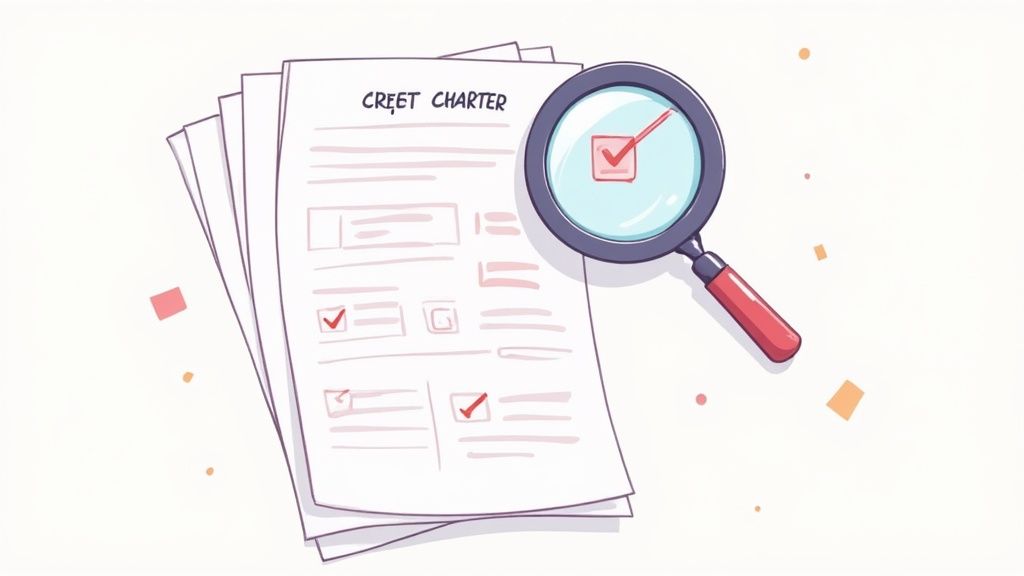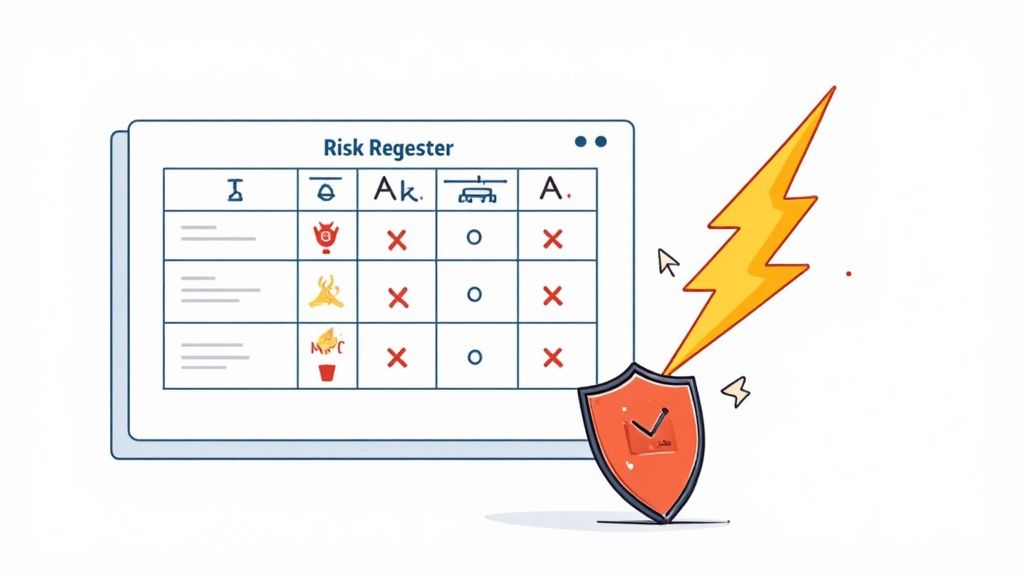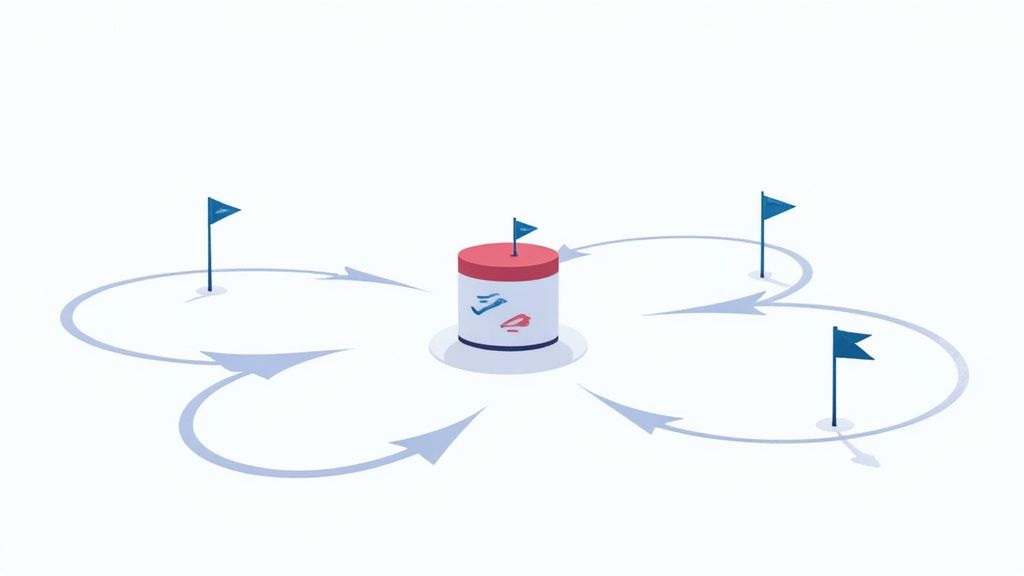
Let’s be honest. Most articles on project management best practices read like a textbook nobody asked for. They’re full of vague theories and buzzwords that sound impressive in a board meeting but fall apart the second a real-world problem hits. Scope creep, ghosting stakeholders, budget black holes… sound familiar? We’ve been there. We’ve mortgaged the office ping-pong table (figuratively, of course) chasing deadlines and trying to herd cats across different time zones.
This isn't another generic list. This is a battle-tested roundup of 10 project management best practices that have saved our bacon more times than we can count, especially when managing the high-performing remote teams we source through LatHire. We’re skipping the fluff and getting straight to what works, what doesn't, and how you can implement these ideas today—without needing a PhD in 'synergistic frameworks'. Forget the abstract Gantt charts that are outdated the minute you save them. This is for the messy reality of modern projects.
Ready to stop managing chaos and start leading projects that actually finish? Let’s get into it.
First things first. Before you write a single line of code or design a single pixel, you need to know exactly what you're building. Neglecting this step is like setting sail without a map or a destination; you'll just burn cash until you're lost at sea. Defining a clear project scope and objectives is the foundational project management best practice that separates the pros from the projects that spiral into chaos. This is the firm ground you build everything else on.
This means creating a detailed project charter that outlines exactly what is in scope and—just as importantly—what is out of scope. Think of it as your project's constitution.

And no, a vague mission statement doesn't count. You need quantifiable success. NASA’s Mars Rover missions had precisely defined scientific objectives, not just "explore Mars." Apple's iPhone development starts with crystal-clear hardware and software specs. This clarity is your shield against the dreaded "scope creep" that can derail even the most promising ideas.
Getting this right isn't a solo mission. It’s a group therapy session with everyone who has a stake in the outcome.
A project isn’t an island; it’s a bustling ecosystem of people with vested interests, competing priorities, and strong opinions. Ignoring them is the fastest way to get your project sunk. Effective stakeholder management and communication is a core project management best practice that ensures you’re not just building something for people, but with them. It’s the difference between a product launch celebrated by all and one that lands with a thud in an empty room.
So, who are we talking about? Everyone from the CEO to the end-user. You need a deliberate plan to keep them informed, engaged, and on your side. Think of it as political diplomacy for your project.

This isn't about sending a weekly mass email and calling it a day. It’s strategic engagement. Tesla's Gigafactory construction required constant communication with local governments, environmental groups, and communities to succeed. The WHO's global vaccine distribution hinged on masterful coordination between dozens of countries. Keeping these lines open prevents nasty surprises and builds the momentum you'll desperately need later.
You can’t just hope for good communication; you have to engineer it. Especially when your team is spread across the globe.
If defining your scope is setting the destination, then risk management is packing for a hurricane. Ignoring potential risks is like assuming every day will be sunny; you’ll be scrambling for cover at the first sign of rain. Systematic risk management is one of the most crucial project management best practices, separating projects that survive turbulence from those that capsize at the first sign of trouble. It’s your project’s pre-mortem.
This means actively identifying, analyzing, and preparing for threats before they derail your timeline or budget. It's your project's insurance policy.

This isn't just about worst-case scenarios. SpaceX doesn't just hope for a smooth launch; they build in multiple backup systems and abort procedures for a reason. Amazon meticulously manages supply chain risks to prepare for disruptions like a global pandemic. This proactive mindset transforms potential catastrophes into manageable inconveniences.
Don’t wait for a crisis to start thinking about your response. That’s called panic. Proactive planning is your only real defense.
In today’s market, the old "waterfall" method often leads to building a perfect product for a world that no longer exists by the time you launch. An agile and iterative approach is your antidote to this. Instead of one massive, high-stakes launch, you deliver value in small, incremental cycles called sprints. This is one of the most essential project management best practices for any team that needs to adapt without breaking.
It’s about prioritizing flexibility, collaboration, and continuous improvement. It allows you to respond to feedback and changing requirements on the fly. Think of it less like building a skyscraper from a fixed blueprint and more like a chef constantly tasting and adjusting a recipe.

Tech giants live by this principle. Spotify’s famous squad model allows small, autonomous teams to develop and release features independently. Why? It empowers teams to move fast without getting bogged down by bureaucracy. Agile isn't just for startups; it scales.
Switching to agile isn't about flipping a switch; it's a cultural shift. Here's how to ease into it.
A project is only as good as the people building it, and even elite talent can't perform without the right resources. Neglecting this is like handing a Michelin-star chef a spoon and a rock and expecting a masterpiece. Effective resource planning and team management are the engine of your project, ensuring you have the right people with the right tools, right when you need them.
This goes beyond just assigning tasks. It’s the strategic allocation of your team's time, skills, and energy. It means understanding individual capacities, preventing burnout, and creating an environment where people can do their best work. Think of Atlassian's "ShipIt" days; they're not just fun, they're a strategic investment in team building and innovation that pays off big time.
Getting your team allocation right isn't about plugging names into a spreadsheet. It’s an ongoing balancing act.
Finishing a project on time and budget is great, but it's a hollow victory if the final product is riddled with bugs. Quality isn't a final inspection; it's a philosophy woven into every step. This is where systematic quality management, one of the most critical project management best practices, prevents you from shipping a polished-looking disaster. It's about building quality in, not bolting it on as an afterthought.
This means defining what "good" looks like from the very beginning and then relentlessly pursuing that standard. It’s the discipline that separates enduring products from fleeting ones. Toyota’s “Kaizen” (continuous improvement) philosophy didn’t just revolutionize manufacturing; it set a new standard for excellence. NASA doesn't just cross its fingers and launch rockets; it employs rigorous quality processes where failure is simply not an option.
Integrating quality isn't about hiring a "quality police" department. It’s about empowering your team to own the outcome.
A project without a paper trail is a project asking for amnesia. When a key team member leaves, that unwritten knowledge walks right out the door with them. Comprehensive documentation isn't bureaucratic red tape; it's your project's institutional memory. This is one of the most overlooked project management best practices, and it’s the difference between learning from history and being doomed to repeat it.
This is about systematically capturing decisions, processes, and lessons learned. Think of it as creating a living blueprint for your project. Atlassian’s entire business revolves around Confluence, a tool designed for this exact purpose. The open-source community thrives because of meticulous documentation, allowing thousands of developers to collaborate asynchronously. It ensures continuity and turns past challenges into future wisdom.
Good documentation doesn't just happen. You have to build the habit into your project's DNA.
Time is the one resource you can't buy more of. Letting it slip through your fingers is a surefire way to kill a project. Effective schedule management isn't just about throwing dates on a calendar; it's the disciplined art of controlling your project’s most finite asset. This is one of those project management best practices that separates the teams that deliver from those that are perpetually "almost done."
This means creating a realistic, living timeline that accounts for every task, dependency, and potential bottleneck. Think of the intense coordination of the Manhattan Project or the tight development timelines for a Formula 1 race car; success was impossible without ruthless schedule control. It’s about knowing your critical path and protecting it at all costs.
Controlling the timeline requires a proactive, not reactive, mindset. You can't just set it and forget it.
A great idea is worthless if you run out of money halfway through building it. Neglecting budget management is the fastest way to turn a promising project into a cautionary tale. This crucial project management best practice isn't about being cheap; it’s about being smart with every dollar. It's the difference between launching a product and launching a fire sale.
This practice involves more than just a spreadsheet. It's about planning, tracking, and controlling project costs with vigilance. Think of the infamous budget overruns of projects like the Boeing 787 Dreamliner, where poor cost management led to billions in extra expenses. Effective cost control ensures you avoid having to actually mortgage the office ping-pong table.
Getting your finances right from the start requires a disciplined, proactive approach, especially with a distributed team.
Change is inevitable. In fact, if your project isn't changing, it's probably already irrelevant. Ignoring this is like trying to stop the tide with a bucket. A structured approach to change management is a critical project management best practice that ensures you can adapt without derailing the entire mission. It’s the difference between a controlled pivot and a full-blown panic.
This isn't about saying "no" to every new idea. It’s about creating a clear process to evaluate, approve, and implement changes. Think of NASA's meticulous configuration management for space missions where a single unauthorized change could be catastrophic. Agile teams don’t just accept random requests; they manage them through a structured backlog grooming and sprint planning process. This control keeps the project on track while allowing for necessary evolution.
A good change management plan prevents your project from becoming a free-for-all where the loudest voice wins. It brings order to the chaos.
| Practice | Implementation Complexity | Resource Requirements | Expected Outcomes | Ideal Use Cases | Key Advantages |
|---|---|---|---|---|---|
| Define Clear Project Scope and Objectives | Moderate (time-consuming upfront) | Moderate (stakeholder involvement) | Prevents scope creep, clear direction | Projects needing precise deliverables | Reduces drift, improves alignment |
| Effective Stakeholder Management and Communication | Moderate to High (many stakeholders) | High (ongoing communication) | Increased support, faster decision-making | Complex projects with multiple stakeholders | Enhances project visibility, reduces conflicts |
| Risk Management and Contingency Planning | Moderate (requires detailed analysis) | Moderate (risk monitoring) | Fewer surprises, improved predictability | High-risk or complex projects | Proactive problem-solving, budget protection |
| Agile and Iterative Development Approach | High (cultural shift and training) | Moderate to High (team collaboration) | Early, continuous value delivery | Projects with evolving requirements | High adaptability, improved quality |
| Resource Planning and Team Management | Moderate to High (complex resource balancing) | High (capacity planning, training) | Optimized productivity, reduced bottlenecks | Multi-project, resource-constrained environments | Enhances team performance, cost control |
| Quality Management and Continuous Improvement | Moderate (requires standards and audits) | Moderate (tools and training) | Reduced rework, higher customer satisfaction | Projects requiring high quality standards | Prevents defects, improves efficiency |
| Comprehensive Project Documentation and Knowledge Management | Low to Moderate (ongoing effort) | Moderate (documentation tools) | Knowledge continuity, supports future projects | Long-term or complex projects | Facilitates learning & onboarding |
| Schedule Management and Timeline Control | Moderate to High (complex dependencies) | Moderate (scheduling tools) | Clear timelines, critical path visibility | Large projects with strict deadlines | Improves predictability, resource optimization |
| Budget Management and Cost Control | Moderate (detailed tracking needed) | Moderate (cost tracking tools) | Financial viability, early overrun warnings | Budget-sensitive projects | Accurate cost control, informed decisions |
| Change Management and Adaptability | Moderate to High (process overhead) | Moderate (change tracking) | Controlled change, stakeholder alignment | Projects with frequent or significant changes | Protects scope, ensures proper evaluation |
So there you have it. A full playbook of ten project management best practices designed to keep your initiatives from spiraling into a chaotic mess of missed deadlines and blown budgets. We've walked through everything from nailing down your scope and managing stakeholders to wrangling schedules and adapting to the inevitable curveballs. Mastering these principles is the difference between a project that launches with a bang and one that limps across the finish line, leaving a trail of exhausted team members in its wake.
But here’s the unvarnished truth, the part other guides conveniently forget to mention: the most meticulously crafted Gantt chart, the most sophisticated risk register, and the most agile framework are all fundamentally useless without the right people driving them. A great process with a mediocre team will always lose to a decent process with a killer team. The real secret isn't just what you do; it's who does it. This is where the real leverage is.
Implementing these project management best practices isn't a one-and-done checklist. It's about building a culture of excellence, and that culture is built by your team. You can spend the next quarter trying to train your existing team, hoping the lessons stick. Or you can stack the deck in your favor from the start.
But that leads to another problem, doesn't it? Hope you enjoy spending your afternoons fact-checking resumes and running technical interviews, because that’s now your full-time job. You're left choosing between building your product and building your team.
Or, you could skip all that drama. At LatHire, we've built our entire business around a simple, powerful idea: great talent is the ultimate project management hack. We connect you with elite, pre-vetted professionals from Latin America who live and breathe these best practices. These aren't just coders or designers; they are seasoned experts who understand communication, risk mitigation, and stakeholder management.
We handle the AI-powered vetting, the skills validation, the international payroll, and the compliance headaches. You get top-tier project managers, developers, and marketers who integrate seamlessly with your existing crew, often working in your own time zone. It’s the shortcut to building a team so good that the process almost runs itself. We’re not saying we’re perfect. Just more accurate more often. (Toot, toot!)
Ready to build a team that makes project management feel less like a chore and more like a victory lap? Let's talk.
